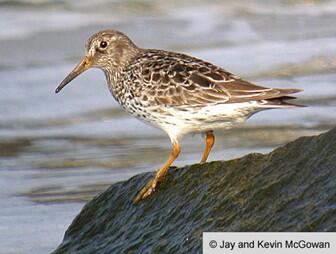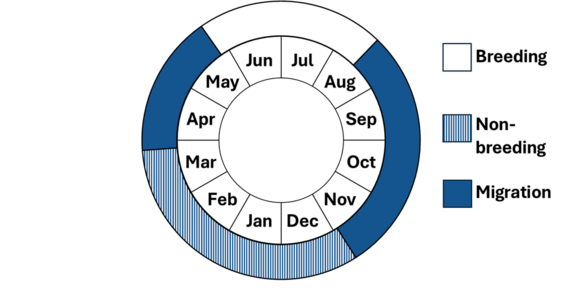- Scientific name: Calidris maritima
Species of Greatest Conservation Need (MA State Wildlife Action Plan)
Description

Purple sandpiper
The purple sandpiper is a medium-sized and stocky sandpiper. In the winter, their non-breeding plumage is characterized by slate-colored upperparts and streaking below. Their black, medium-sized bill is slightly downturned with an orange base. Their breeding appearance is brighter overall from a light brown plumage to brighter orange legs. Females are slightly larger than males, which is most noticeable in bill length.
Life cycle and behavior
Phenology: The purple sandpiper is a migratory shorebird. It is less gregarious than other Calidris species but does migrate in large flocks. They are relatively long-lived with a socially monogamous and territorial mating system, long-term pair bonds, and a high level of paternal investment. Males establish and occupy territory within days of arrival on breeding grounds in late May–early June. Females typically lay one clutch of four eggs. Both adults share incubation duties for three weeks. Females will leave the nesting site and begin migrating shortly after eggs hatch. Chicks depart the nest after about 24 hours and males remain behind for several more weeks to tend the precocial young. Adults do not feed young but lead them to favorable foraging areas where chicks find prey items on tundra surface. Chicks appear to locate prey among vegetation primarily by sight, seizing food by pecking. At four to five weeks, chicks are capable flyers, and the male departs the breeding grounds. Fall migration is less synchronous and more protracted than spring migration, beginning in August and going through November. The maximum recorded age for an adult is at least 20 years.
The diet of this species changes seasonally from marine mollusks and other invertebrates in winter, to arthropods (marine and terrestrial) and seeds in summer. It feeds within the rocky intertidal zone and occasionally on sandy beaches or muddy pools.

Phenology in Massachusetts. This is a simplification of the annual life cycle. Timing exhibited by individuals in a population varies, so adjacent life stages generally overlap each other at their starts and ends.
Population status
The overall population is estimated at 170,000-220,000 birds. However, limited systematic information prevents thorough assessment of population trends. There is little information for North America, where breeding densities in northern regions may be lower than in the West Palearctic (particularly Iceland and Svalbard) and outside North America, nesting densities (summarized over several breeding areas) range from 0.4 to 11 nests/km2 (1 to 29 nests/mi2).
Distribution and abundance
In North America, purple sandpipers primarily breed on islands in the high Canadian Arctic south to the eastern shore of the Hudson Bay. In the Palearctic, the breeding distribution is patchy, with Iceland and Svalbard as the main centers. During the non-breeding period, the purple sandpiper has the most northerly distribution of all shorebirds (Greenland, Canada, United States). In Massachusetts, this species is predictably found during the winter months on rocky shorelines and is most common along the coast of Cape Ann.
Habitat
They nest on mossy tundra, heath, moorlands, rocky ridges, coarse gravel-sand beaches along rivers, and along barren coastal beaches. In the high Arctic, this species typically breeds from sea level to approximately 300 m (985 ft) in elevation. In the low Arctic and subarctic, they are primarily an inland nester on uplands and near the fringe of frozen ground. In Canada, they have been documented breeding far inland and on low tundra near shore and on coarse gravel-sand beaches along rivers. Their feeding habitat during the breeding season includes patches of wet tundra and the intertidal zone.
In their wintering range, purple sandpipers are found on rocky shorelines, jetties, breakwaters, and rocky islets and peninsulas. Occasionally, they overwinter on mudflats or sandy shores.
Healthy habitats are vital for supporting native wildlife and plants. Explore habitats and learn about conservation and restoration in Massachusetts.
Threats
Pesticides, oil, and other contaminants, and degradation of habitat may affect local populations. Egg collecting for human consumption also may impact some populations. Habitat loss and degradation from global climate change may pose the biggest threat to this species.
Plastic trash in the environment poses a threat as it can be mistaken as food by seabirds and shorebirds and ingested or cause entanglement. Ingested plastics, common for seabirds, can block digestive tracts, cause internal injuries, disrupt the endocrine system, and lead to death. Entanglement from fishing gear and other string-like plastics can cause mortality by strangulation and impairing movements.
Conservation
No management measures have been taken to date. A high management priority for the eastern North Atlantic region is to identify and protect sufficient winter habitat for purple sandpiper, including rock jetties and shorelines. A thorough winter survey is needed to better understand the species distribution and abundance in specific regions and to identify important sites for wintering birds.
Most research on purple sandpipers has taken place outside of North America, on breeding grounds in the northwestern Palearctic (Arctic Ocean islands and northern Scandinavia) and on wintering grounds in the midwestern Palearctic (for example, Scandinavia, the Netherlands, United Kingdom). Only a few studies have considered this species in North America, so results are mostly from studies of populations elsewhere, particularly from the eastern part of the species' range.
Population-monitoring programs should be established in breeding and wintering areas where greatest number of sandpipers occur, combined with winter banding (for estimates of productivity and mortality). Studies identifying and quantifying factors that influence population dynamics on breeding, migration, and wintering grounds are also needed. In addition, many basic aspects of the species biology need further research.
Avoid or recycle single-use plastics and promote and participate in beach cleanup efforts.
References
Payne, L. X. and E. P. Pierce (2020). Purple Sandpiper (Calidris maritima), version 1.0. In Birds of the World (S. M. Billerman, Editor). Cornell Lab of Ornithology, Ithaca, NY, USA. https://doi-org.silk.library.umass.edu/10.2173/bow.pursan.01
Contact
| Date published: | April 4, 2025 |
|---|